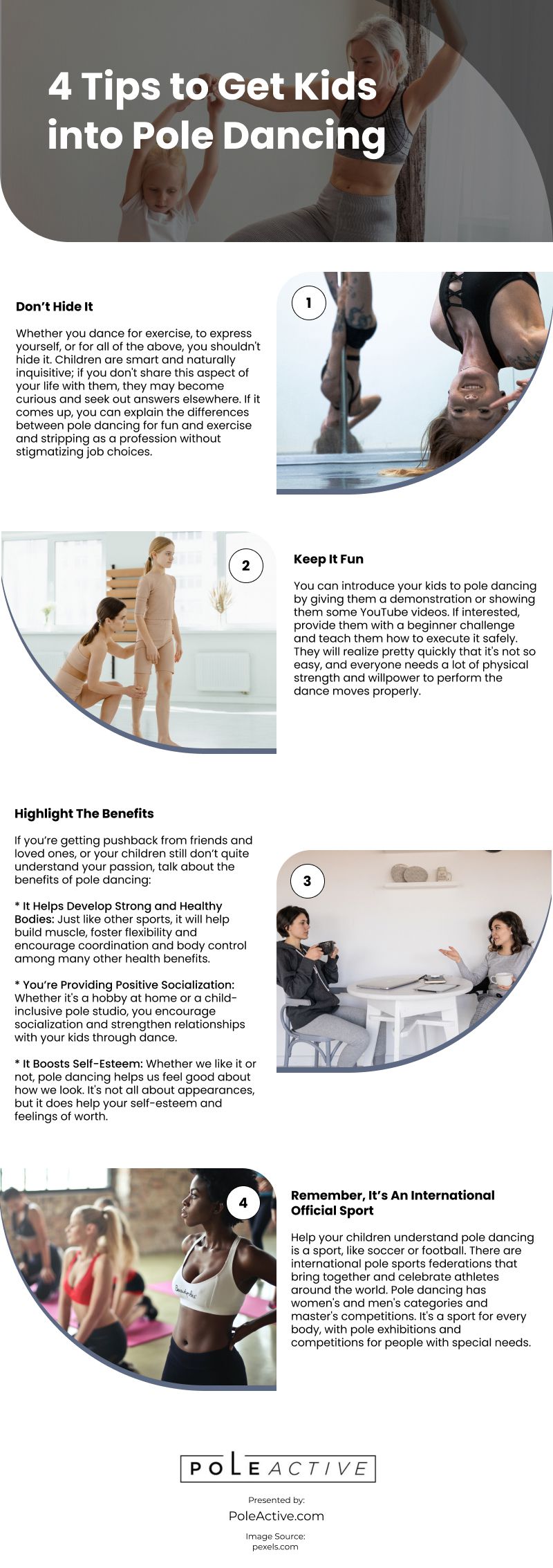
Pole dancing has been a popular form of fitness and entertainment for adults for many years, but other things may come to mind when considering activities for children. However, pole dancing can be a fun and beneficial activity for kids, providing various physical and mental benefits. This infographic will explore why introducing pole dancing to your kids can be a positive experience.
Physical Benefits
Pole dancing is a full-body workout that can help improve strength, flexibility, and coordination. By practicing pole dancing, children can build their upper body strength by pulling themselves up and holding their body weight on the pole. Pole dancing also requires the use of the core muscles, which can help to improve balance and stability. Additionally, pole dancing can increase flexibility by encouraging children to stretch and move their bodies differently.
Mental Benefits
In addition to the physical benefits, pole dancing can also provide mental benefits for children. Pole dancing requires focus and concentration, which can help children develop their ability to focus and improve their overall mental well-being. Furthermore, pole dancing can help children to build confidence and self-esteem as they learn new moves and master new skills. Finally, pole dancing can be an excellent way for kids to explore their creativity and express themselves as they learn new routines.
Safety Considerations
When introducing pole dancing to children, it is important to ensure that safety is a top priority. Children should always be supervised when practicing pole dancing, and the pole should be securely installed and maintained to prevent accidents. Additionally, it is important to ensure that children wear appropriate clothing and footwear to avoid slips and falls. It is also essential to teach children proper stretching and warm-up exercises before beginning pole dancing, which can help prevent injuries. Finally, it is necessary to discuss the importance of listening to their bodies and stopping if they experience pain or discomfort.
Age Considerations
Pole dancing can be fun for children of all ages, but it is important to consider age appropriateness when introducing it. Younger children may benefit from more basic moves and exercises, while older children may be able to perform more advanced actions. Tailoring the activity to the child’s age and ability level is essential to ensure they are safe and comfortable. Additionally, discussing safety protocols and potential injuries with your children before beginning is vital. It may be beneficial to start slowly, even for older children, so your child can become comfortable with the sport before progressing to more advanced moves. This will help ensure their safety and allow them to develop strength and skill over time. Furthermore, it is essential to emphasize that pole dancing should be fun and not a competition, as this will help them develop a positive outlook toward the sport and prevent potential injuries.
Parental Involvement
When introducing pole dancing to your kids, it can be helpful to get involved yourself. By practicing together, you can bond over a shared activity and provide your child with support and encouragement. Furthermore, practicing pole dancing together can set a positive example and encourage healthy habits.
Overall, introducing pole dancing to your kids can be a positive experience with physical and mental benefits. You can help your child develop new skills, build confidence, and improve their overall well-being by emphasizing safety, age appropriateness, and parental involvement.
source: https://www.poleactive.com/blogs/news/introducing-pole-dancing-to-your-kids
Comments
Download this infographic.
